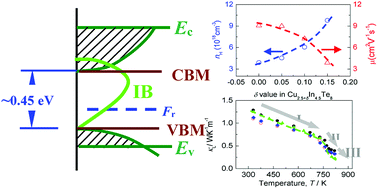Improvement of thermoelectric performance of copper-deficient compounds Cu2.5+δIn4.5Te8 (δ = 0–0.15) due to a degenerate impurity band and ultralow lattice thermal conductivity†
Abstract
Cu–In–Te ternary chalcogenides have unique crystal and band structures; hence they have received much attention in thermoelectrics. In this work we have observed an enhancement in Hall carrier concentration (nH) and ultralow lattice thermal conductivity (κL) when Cu was added to ternary Cu2.5+δIn4.5Te8 (δ = 0–0.15) compounds. The enhancement in nH is attributed to a degenerate impurity band at the G point in the valence band maximum (VBM), while the extremely low κL results from the increased lattice disorder. We thus obtained the minimum κL value of only 0.23 W K−1 m−1 in the sample at δ = 0.1 and 820 K, which is in good agreement with the calculation using the Callaway model. The highest thermoelectric figure of merit ZT is 0.84 for the material at δ = 0.1, which is about 0.38 higher than that of the pristine Cu2.5In4.5Te8.



 Please wait while we load your content...
Please wait while we load your content...